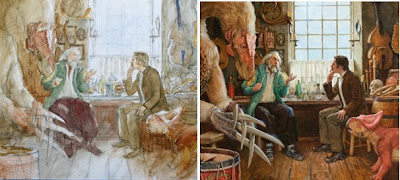 When I paint an imaginary scene in oil, I usually try for three strategies in the first statement:
When I paint an imaginary scene in oil, I usually try for three strategies in the first statement:1.Establish the overall color temperature for each region of the picture.
2. Suggest the large tonal statement of light and dark.
3. Keep everything a little lighter than the final rendering will be.
Following strategy #3 leaves you the option to achieve your final color rendering either transparently or opaquely. If you go too dark too soon, you can only correct it with opaques. Comparing the first step with the final below of Old Conductor from Journey to Chandara, the washin should look like the intended finish with a piece of tracing paper laid over it.
 The reason for #2 is that every judgment needs to be seen in context. If you paint each area starting from white, like paint-by-numbers, it’s harder to make accurate choices. It can be done, but to me it makes more sense for observational work.
The reason for #2 is that every judgment needs to be seen in context. If you paint each area starting from white, like paint-by-numbers, it’s harder to make accurate choices. It can be done, but to me it makes more sense for observational work.The first strategy could be called a color imprimatura. A moonlight scene might be washed all over with a light blue-green. If the scene has different colored lights, each light region should be bathed in the color of each source. If there are multi-colored light sources, a white object will take on the relative color of each source.
------
Thanks to Online University Reviews for naming Gurney Journey one of the "100 Best Scholarly Art Blogs" (#65, right next to my buddy Tony DiTerlizzi.) Kudos to my assistant professor, my budgie!
------
Earlier post on "Area-by-Area" painting, link.
Part 1: Initial Sketches
Part 2: Researching Insect Flight
Part 3: Maquette
Part 7: The Painting







7 comments:
Really enjoying watching your approach on this project. Thanks for sharing.
So the utopiales piece used method 1? I might have to try that...
I've been studying oil techniques in an attempt to prove my digital painting skills (though I should probably grab myself some actual oils...) A common thing I've noticed in some paintings is using a monochromatic tonal wash beforehand, to set up your values, then start a wash of colors over that. Is this considered the second method, or something else entirely?
100 Best Scholarly Art Blogs
I concur! I have been studying 'serious' painting in NYC for five years now - and while the training is great, there is suprisingly little discussion or information 'out there' about painting from the imagination, or even painting 'realistically' but not necessarily what's in front of you...i don't doubt your book coming out in sept will fill a lot of gaps, the same way Juliette Arstides books on classical painting and drawing have.
(and no Mr. Gurney did not pay me to write this :) )
Drew, good questions, and I see my writing wasn't clear. I meant to say that I try to do all three strategies at once in this kind of painting: establish color atmosphere, work out values, and keep it fairly light.
This first stage goes down very quickly with transparent oil color and a big bristle brush, scrubbing across large areas. It's dry in a few hours, ready for the next layer.
Thanks, I, me. That art blog list includes a bunch of great art blogs that I admire, such as Lines and Colors, Making a Mark, and Drawn. But I think they missed some great ones, like Irene Gallo's blog (The Art Department), David Apatoff's (Illustration Art), and Armand Cabrera's (Art and Influence). Those should be linked on my blogroll.
So you let the transparent wash dry first before you start painting over it -- and not painting into it like Loomis suggests?
I guess, when I think about it he's talking about a single overall tone and not a full blown transparent block-in (like the Chandara example).
Do you use any medium?
I really like painting into a tone made using the Ralph Mayer medium mix while its still wet -- I just find it a really receptive surface. It doesn't cause too much glare (which is the problem I've had with Liquin).
That should have said, "and not painting into it WET like Loomis suggests?"
I need more sleep...
Watching this unfold is fascinating. Thanks for posting the process. (I'd make some parakeet joke, about the video in your last post, but I think the topic has been well addressed.)
Post a Comment